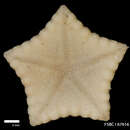Comprehensive Description
(
anglais
)
fourni par Smithsonian Contributions to Zoology
Tosia parva (Perrier)
Pentagonaster parvus Perrier, 1881a:19; 1884:36, 37, 231, pl. 7: figs. 7–8.–Sladen:265, 267, 746–747.
Goniaster americanus (part) Verrill, 1899:154–156, pl. 26: fig. 6.
Plinthaster dentatus (part).–Gray, Downey, and Cerame-Vivas, 1968: fig. 25.
Tosia parva.–Halpern, 1969b:503–506, fig. 1.
The form is pentagonal. The abactinal plates are polygonal to round, slightly convex, and surrounded by a single row of large, flat, square granules which, in the radial areas, are frequently fused to form a continuous ring around the plate. Five or more of the abactinal primary plates are larger than the rest of the abactinal plates. The center of each abactinal plate bears 0–6 round granules embedded in deep pits. Papulae are confined to an oval radial area. There are 6–8 massive, tumid superomarginal plates, each surrounded by a single row of small, rounded granules. Single, small, round granules or clusters of up to twelve granules are scattered over the surface of the plates.
There are 8–10 inferomarginal plates corresponding to the superomarginals and similar to them, but usually bearing more than one row of peripheral granules. Between the two series of marginals are several rows of enlarged granules, those at the inframarginal angles being particularly large. The large, flat, rhombic actinal plates are arranged in five chevrons and are surrounded by two or three rows of coarse, round granules; many of the plates have a more or less extensive central naked area. The adambulacral plates have a straight furrow margin bearing five subequal, compressed, blunt-tipped spines. The subambulacral spines are in 3 or 4 irregular rows of 3–5 short, granuliform spinules. The mouth plate margin bears spines similar to the adambulacral furrow spines but more compressed; the median spine is not conspicuously enlarged. The rest of the mouth plate bears a few angular granules. The madreporite is of moderate size and roundly triangular. The oculars are small and naked. Pedicellariae are rare; when present, they are small, with two slender valves embedded in deep pits, and confined to the actinal surface.
This species ranges from North Carolina to Trinidad, in 30–597 meters.
MATERIAL EXAMINED.–Silver Bay Station 2020 (1) [R=18 mm, r=12 mm, Rr=1:1.5]. Oregon Stations: 5915 (1) [R=12 mm, r=8 mm, Rr=1:1.5]; station unknown (6) [R=22 mm, r=15 mm, Rr=1:1.5].
Rosaster Perrier
Rosaster Perrier, 1894:36. [Type, by monotypy, Pentagonaster alexandri Perrier.]
- citation bibliographique
- Downey, Maureen E. 1973. "Starfishes from the Caribbean and the Gulf of Mexico." Smithsonian Contributions to Zoology. 1-158. https://doi.org/10.5479/si.00810282.126

